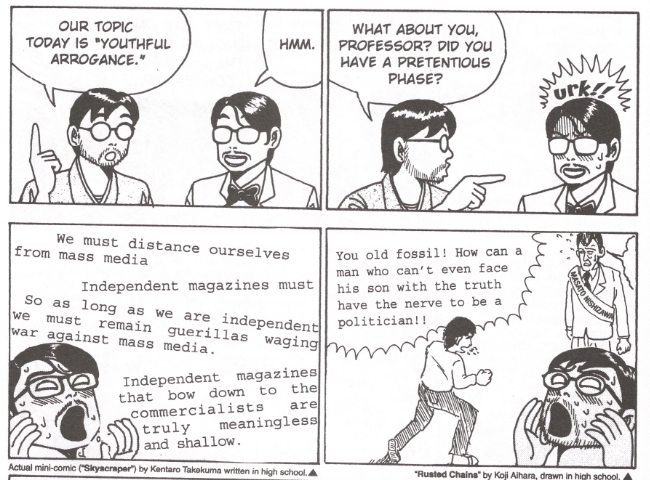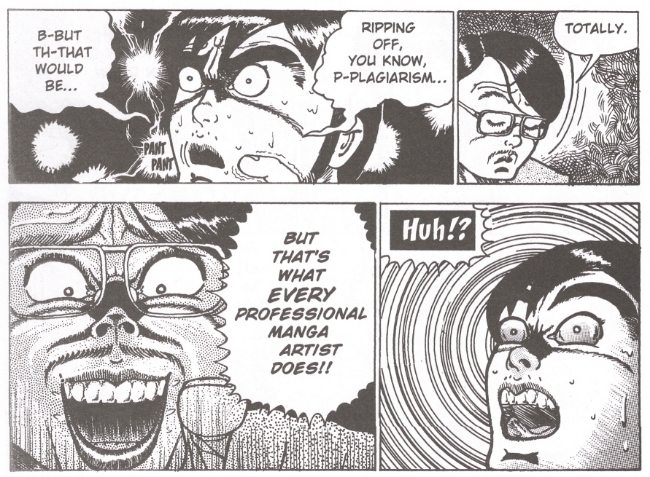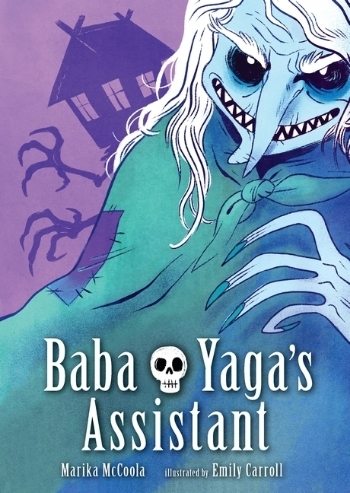I have utilized this powerful message numerous times in the last few months, though I fear I have never quite done it justice. It's from Even a Monkey Can Draw Manga, the project of joint artists Kōji Aihara & Kentarō Takekuma, first translated to English as a recurring feature in the final issues of VIZ's lamented mature readers magazine Pulp and subsequently compiled into single volume in 2002; you may recall myself and commenter Chris V. bringing it up two weeks ago as part of a discussion of the mega-marketed CoroCoro Comic, and by god there was probably no better a place for that.
Know first that Monkey is satire. In fact, it is something of a period piece, having been initially serialized in the pages of Shogakukan's Big Comic Spirits in 1989 and 1990; that VIZ saw fit to translate portions of it over a decade later speaks to the bravura density of its lampoon, which follows fictionalized versions of the authors as they set out to become the ultimate manga superstars, learning all the most important tricks of the trade along the way. Accompanying the comic are helpful charts and text-format sidebars such as the "MOTHER & CHILD LIFE LESSON!" excerpted above. "Effort, Friendship, Victory" -- or, doryoku, yūjō, shōri -- is the classic editorial theme of Shōnen Jump, the boys' comics gargantuan and primary venue for big, filthy megahits: in this way, the physical and mental care of morning calisthenics are bonded completely with the audience service of big-time comics publishing via Aihara's & Takekuma's parody.
Naturally, such advice comes from hard experience.
It was with some amusement that I realized if you put these two indiscretions together, you wind up with something not unlike the wry student protest story from Trash Market, Drawn and Quarterly's recent release of 'art' comics by Tadao Tsuge, an artist who spent much of his daily life after a brief flurry of livable activity with the oppositional magazine Garo managing a men's apparel store, unrepentant about how poorly irregular editions of his work sell. Men like Tsuge do not exist in the version of reality posited by Monkey, where the only conceptualization of comics is that of a purely commercial entity. And, to be honest, the authors do seem genuinely embarrassed by the youthful arrogance they submit for our disapproval - Big Comic Spirits is not a small magazine, and Shogakukan is a broadly mainstream publisher. Seinen manga of the type published by them tend to adopt a poise not completely unlike network television dramas, which speaks to the ease with which comics are still accepted in Japan as mass culture; and who speaks of creating 'art' television around here, rather than simply pursuing the better cable narratives available in that land of riches? Some, I'm sure, but not so many.
In this way, Monkey lacks the call to arms or the righteous sarcasm you might expect from an American satire; instead, its characters accept the terrain as given, and move to analyze it, without any gesture toward affecting change. It is, nonetheless, not a kindly study: the core joke of Monkey is that manga, as a commercial art, can be understood fully -- indeed, mastered -- through the adept clicking together of pre-made commercial parts; there is no shame in swiping poses or ideas from other artists, as comics is fundamentally a language of shared symbols, which can only realize meaning through simple variations on repetitious usage. This is illustrated most vividly through likening the desirous components of "ladies' comics" (from which josei would later distinguish itself as a less porny manifestation) to falling Tetris blocks, but the machinations of shōjo romance are likewise compared to the rigid formalities of sumo wrestling, while the sexual conquests of a seinen erotic comedy hero are presented as conveyer belt sushi - very mechanical! With the wave of a finger, Takekuma observes that no other type of young men's manga is relevant: everything boils down to the immediate gratification of desire by the most streamlined means.
I could not give you an accurate timeline of the evolution of the Japanese hug pillow to include anime characters with which you can physically sleep, but regardless, the above tableaux demonstrates that Monkey was either capable of predicting real trends through its worldview or at least willing to rope in real phenomena to bolster its comedy thesis. Of course, we in English only got part of it - not only did the 2002 VIZ collected edition omit portions of the first Japanese release, but it was never followed up by subsequent chapters, which I understand get into more specified spoofing of editorial culture, and even a comic within the comic created by the creators' alter egos. The series was reissued in 2006 as a pair of 300+ page books, with new and updated content, while a full-blown sequel ran in 2007-08 in Shogakukan's now-defunct 'alternative'-flavored seinen magazine IKKI, though this latter effort has never been released anywhere in collected form.
Not long after, in 2009, VIZ experimented with releasing IKKI series online, with print editions to follow; Even a Monkey Can Draw Manga was not on the schedule. My standard joke is that they only published the series in the first place, in those immediate pre-boom years, before they figured out for themselves what commercial product would actually sell better, but this is probably only part of the story. Loaded with textual notations and quarter-century old jokes -- more than one crack is made at the expense of Offered, a famously lunatic Kazuo Koike/Ryōichi Ikegami series that happened to be running in Big Comic Spirits at the same time, while a chapter on salaryman manga mashes up Kenshi Hirokane's quintessential office hero Kōsaku Shima with the public craze for Nintendo's Dragon Quest IV -- I can't imagine this would be a extremely easy series to translate, even with favorable economic prospects. Tellingly, nobody online to my knowledge has bothered to attempt an unauthorized translation either, which is really the ultimate irony for a work so dedicated to revealing the secrets of commerce - you can't even steal this shit.
***
PLEASE NOTE: What follows is not a series of capsule reviews but an annotated selection of items listed by Diamond Comic Distributors for release to comic book retailers in North America on the particular Wednesday identified in the column title above. Be aware that some of these comics may be published by Fantagraphics Books, the entity which also administers the posting of this column. Not every listed item will necessarily arrive at every comic book retailer, in that some items may be delayed and ordered quantities will vary. I have in all likelihood not read any of the comics listed below, in that they are not yet released as of the writing of this column, nor will I necessarily read or purchase every item identified; THIS WEEK IN COMICS! reflects only what I find to be potentially interesting.
***
SPOTLIGHT PICKS!
Bright-Eyed at Midnight: Being the newest book release from Leslie Stein, whose Eye of the Majestic Creature series has picked up a lot of praise since its bookshelf-format debut in 2011. As with those earlier books, Fantagraphics publishes this 224-page hardcover, collecting nightly pages the artist drew throughout 2014, exploring "her 1980s childhood, dreams, travel, artist’s block, drinking, recording and playing rock shows, and bar patrons, along with quiet moments of introspection and loneliness"; $22.99.
Baba Yaga's Assistant: Meanwhile, the very popular horror specialist Emily Carroll -- who just released a new webcomic short last month -- makes her full-length graphic novel debut with writer Marika McCoola on a kid-appropriate folkloric riff involving a would-be helper of the Slavic legend. Candlewick Press publishes the 136-page color hardback. This is not the last collaboration we'll see from Carroll, who is working on a comics adaptation of Laurie Halse Anderson's hugely admired 1999 YA novel Speak; $16.99.
--
PLUS!
The Adventures of Drippy the Newsboy Vol. 1 (of 3): Drippy's Mama: The Drippy Gazette was founded in 1999 as a means of representing Vancouver's arts scene, and subsequently spun out into Drippytown Comics, which was supported with a Xeric grant. Now artist Julian Lawrence presents a 64-page, 7.5" x 10" softcover album detailing droplet mascot Drippy's personal affairs, "harken[ing] back to adventure serials like Tintin, complete with nostalgia and epic storytelling, but with much more drinking, gags, and carrying on." The fine Canadians at Conundrum publish; $12.00.
Dark Corridor #1: An Image debut. So many comics are Image debuts! But this one, friend, is an Image debut by writer/artist Rich Tommaso, longtime indie comics veteran (and re-colorist for Fantagraphics' Carl Barks releases). While ostensibly an ongoing series, it actually looks to function as a one-man anthology, albeit serializing only one story at a time, starting with "The Red Circle", a crime drama "about revenge and the destruction of the male-dominated mafia," per the artist. All in color too - one to watch. Preview; $3.99.
Death in Oaxaca #2 (&) Study Group Magazine 3D: A pair of Alternative Comics releases, although only one is an Alternative publication. That would be Death in Oaxaca, the continuing Steve Lafler series about weird happenings in the titular town in a languid, slice-of-life vein, as explicated by Rob Clough in his review of issue #1 elsewhere on this site. Study Group Magazine, meanwhile, is a Study Group publication distributed by Alternative, and also the very rare item in this rundown to earn the ***ULTIMATE CONFLICT OF INTEREST DESIGNATION*** by including work by me: an essay on the French publisher Le Dernier Cri's 2011 anthology 3DC. Other 3D-themed writings and comics (some actually in 3D) are included from the likes of Kim Deitch, Jason Little, Jim Rugg, Zack Soto, Connor Willumsen, Dan Zettwoch, Chris Cilla, Pete Toms, Ron Wimberly (interviewed by Milo George), Mia Schwartz, Benjamin Urkowitz, Trevor Alixopulos, David King, Julia Gfrörer, Sean T. Collins, Sarah Horrocks, James Romberger, Rob Clough, Sean Witzke, Mary Fleener, Melinda Gebbie and Alan Moore, the lattermost three writing in tribute to the late Ray Zone. It's 96 pages, and glasses are included; $4.99 (Oaxaca), $16.00 (Study Group).
Jojo's Bizarre Adventure Part 1: Phantom Blood Vol. 3 (of 3): Concluding VIZ's release of the earliest, late 1980s work from Hirohiko Araki's sprawling, still-running Jojo line of whatever-I-feel-like serials. Interest in Araki seems to have exploded lately, due to an extensive run of television anime adaptations of comics like these: wildly overheated interpersonal dramas set among muscular hulks with horror, martial arts and western rock music elements. Perhaps a certain palate is necessary to enjoy such flagrantly ludicrous boys' adventure stuff, but I am compelled to note it is also one of the very few examples of popular manga from that time period readily in print at the moment. Battle Tendency, the second Jojo storyline, begins in the same 300+ page hardcover format this November; $19.99.
James Patterson's Zoo: The Graphic Novel: Your local Barnes and Noble probably has a life-sized cardboard standup looming over the new release table right now, depicting famous multimedia entity Patterson glowering behind a fierce lion. "James Patterson is a friend to lions," I thought, "unlike that other guy." Zoo was initially a 2012 nature-versus-humans novel by Patterson and frequent co-writer Michael Ledwidge, but now it is a television show, and thus warrants a re-release of the novel's three-year old official comics adaptation, which -- in one of those interesting bookseller quirks -- is probably stocked in the manga section, since publisher Yen Press mostly deals with Japanese comics, and has previously released several manga-style comics versions of other Patterson-fronted endeavors. Or maybe James Patterson is trying to tell us that we're all united... by love. Anyway, I'm mentioning this 208-page softcover because the artist is Andy MacDonald, whom I remember as co-creator of Image's 2004-06 urban robot series NYC Mech, though he has done more recent work at DC and elsewhere. Preview; $17.00.
American Barbarian: The Complete Series: Also in reissues from 2012, here is a 256-page IDW edition of Tom Scioli's raging Kirbyesque adventure webcomic, initially printed by AdHouse, but now poised to accompany the artist's ongoing Transformers vs. G.I. Joe. With a new process section and an introduction by Rob Liefeld. Preview; $29.99.
Berkeley Breathed's Academia Waltz and Other Profound Transgressions: Now that Bloom County has returned for 2015, why not race back to the '70s with this 304-page IDW hardcover collecting Breathed's University of Texas at Austin newspaper strips, along with additional preliminary items? As with the publisher's releases of later works by the artist, it is 11" x 8.5" in landscape format; $39.99.
Frank Miller's Daredevil - Artifact Edition (&) Dripping with Fear: The Steve Ditko Archives Vol. 5: Two reprint collections of special interest. Daredevil is the latest in IDW's extensive line of original-art-in-color books, a 12" x 17", 144-page array of pages (not full stories, as this is an "Artifact" edition) taken from Miller's late '70s/early '80s tenure on the Marvel superhero, with additional drawing by Klaus Janson and some inks by Terry Austin and Josef Rubinstein. Dripping with Fear, on the other hand, extends Fantagraphics' uniform line of chronological 7.25" x 10.5" Ditko hardcovers for another 200+ pages, though I'm most interested in seeing editor Blake Bell's examination of Ditko's friendship with the sex artist Eric Stanton, with whom he began sharing a studio during the period covered by these stories; $75.00 (Miller), $39.99 (Ditko).
The Art of Satoshi Kon: This one's only tangentially related to comics, although publisher Dark Horse has recently brought over some of the late Kon's unfinished manga projects, so the connection is there. Nonetheless, it'd be ridiculous to deny that the man of the title is renowned mostly for his directorial work in anime, and I strongly suspect that will be the main focus of this career-spanning 136-page hardcover, 8.25" x 11.5", which sets out to showcase Kon's own illustrations, including pieces created for The Dreaming Machine, the feature film in production at the time of his death. A tribute by filmmaker Darren Aronofsky is also promised. Samples; $29.99.
The Comics of Joe Sacco: Journalism in a Visual World: Finally, your book-on-comics of the week - a 272-page priced-for-the-classroom University Press of Mississippi collection of writings on the preeminent non-fiction cartoonist, edited by Daniel Worden. Topics include "how Sacco's comics journalism critiques and employs the 'standard of objectivity' in mainstream reporting, what aesthetic principles and approaches to lived experience can be found in his comics, how Sacco employs the space of the comics page to map history and war, and the ways that his comics function in the classroom and as human rights activism." I'm not expecting relentless Centrifugal Bumble-Puppy coverage, but my heart remains open to surprise; $60.00.












